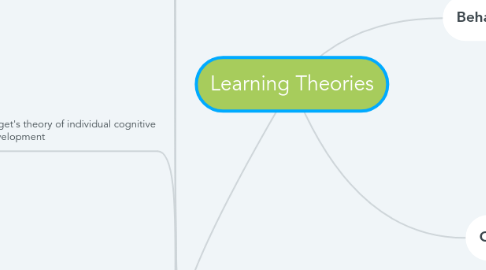
1. Cognitivism
1.1. Views learning as an active process of knowledge construction, not well known by teachers. Teacher don;t recognize how learning is seen or defined from a cognitive perspective
1.2. The limitations of behaviorism created the cognitive movement
1.2.1. "Cognitive revolution"
1.2.1.1. Second half of the 20th century outburst of memory, attention, concept formation and information processing
1.3. Focuses on meaning and semantics
1.4. How knowledge is acquired, processed, stored, retrieved and activated
1.4.1. Learning as an active process
1.5. Pays more attention to what learners actually know
1.5.1. Multifaceted
1.6. Piaget's theory of individual cognitive development
1.6.1. Required adaptation to environmental demands
1.6.2. Children seek environmental stimulation
1.6.3. Stages are sequential and depend on eachother to develop
1.6.4. Qualitative differences in cognitive abilities
1.6.5. Mechanism of change = Equilibria
1.6.5.1. In a new learning situation, we draw on prior knowledge to make the new experience easier to understand
1.6.6. Reorganize our schemata by the use of adaptation
1.6.6.1. Schema is a hypothetical mental structure for organizing and representing generic events and abstract concepts stored in the mind in terms of their common patterns
1.6.6.2. Constantly restructured
1.6.6.3. Three processes help to understand schematic acquisition and the changes in existing schemata
1.6.6.3.1. 1) Accretion - remembering new information without changing the schema
1.6.6.3.2. 2) Tuning - when new information doesn't fit the existing schema causes the schema to be modified
1.6.6.3.3. 3) Reconstructing - characterized by the formation of all new schema with the idea that previous ones cannot accommodate new experiences
1.6.6.4. Assimilation - a process of integrating new information with existing knowledge)
1.6.6.5. Accommodation - a process of modification or transformation in existing cognitive structures in response to a new situation
1.7. Vygotsky's theory of social cognitive growth or zone of proximal development
1.7.1. Categorical perception, logical memory, conceptual thinking, and self regulated attention
1.7.2. Social learning likely precedes development
1.7.3. Culture plays a big role
1.7.4. Genetic development
1.7.5. Auxiliary stimuli
1.7.6. Zone of proximal development
1.7.6.1. "The distance between the actual development level as determined by independent problem solving and the level of potential development as determined through problem solving under adult guidance or in collaboration with more capable peers"
1.7.6.2. Scaffolding
1.7.6.2.1. helping to move to a stronger understanding (not from article)
1.7.6.3. Instruction
1.7.6.3.1. Demonstrations
1.7.6.3.2. Illustrative examples
1.7.6.3.3. Constructive feedback
1.7.6.4. Social partners need to be at different levels of development
1.7.6.5. Individualized testing
1.8. Festinger's cognitive dissonance theory
1.9. Spiro's cognitive flexibility theory
1.10. Sweller's cognitive load theory
1.11. Bruner's cognitive constructivist learning theory
1.11.1. Tolman's theory of sign learning (Bridge between behaviorism and cognitive theory)

